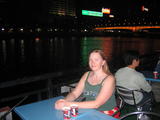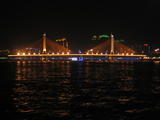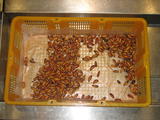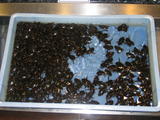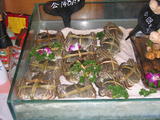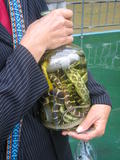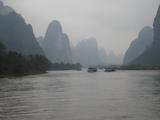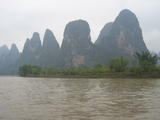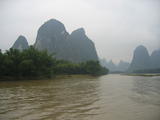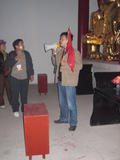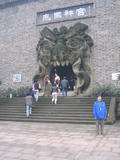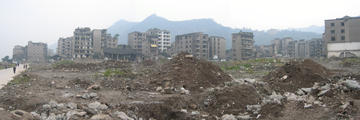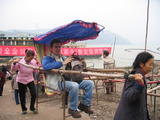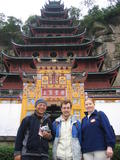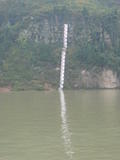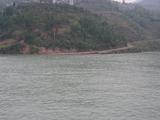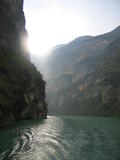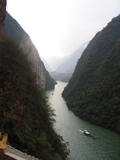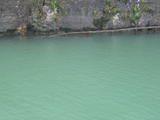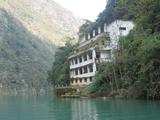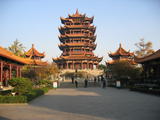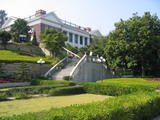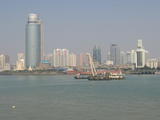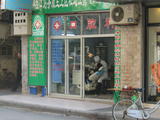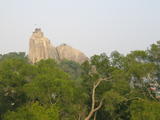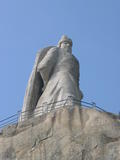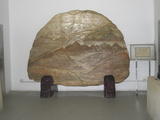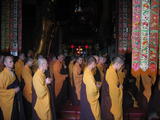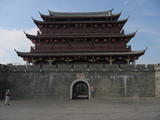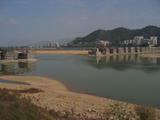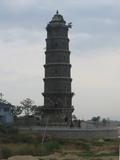| < < < Previous story | Next story > > > | |
In China "everything is more beautiful now!"Hualien, December 5th, 2004
Contents:GuangzhouFrom Tokyo we flew to Taipei, where we remained a few days before flying on to Hong Kong. Hong Kong is the easiest place from which to enter mainland China. First of all, there is barely any hassle to getting a visa here and secondly a good train connection links Hong Kong to Guangzhou, from where you can start to arrange onward travel in China at Chinese prices. In the train to Guangzhou I finally got the feeling that I was traveling again into the unknown. Once in Guangzhou we settled on the island of Shamian a former trading concession to France and England. This is also the first time that we saw restaurants having all kinds of live animals in containers on display for customer to choose which particular one they want to eat. The concept kind of cut our appetite, especially as some of the animals where turtles, snakes and even really disgusting looking water beetles! In the streets of Guangzhou, we saw many western couples with young Chinese children. Apparently adoption is another booming business in China, as the Chinese themselves don't like to adopt while in western countries there is shortage of adoptable babies. Our first impression of Chinese people was that they acted somewhat nervous around us, but we didn't quite manage to put our finger on the cause with certainty. Most likely it is because they feel unsure of how to deal with foreigners. Yangshuo and the Li RiverHaving discovered how cheap it is to fly in China, we flew on to Guilin, where the famous Li river flows between magnificent peaks. The kind of landscape reminiscent of Chinese scroll paintings that you may see in your local Chinese restaurant. A cruise on the Li river starting near Guilin ends in Yangshuo. Yangshuo is a mellow place with a very nice main street filled with little shops, restaurants and bars. A great place for backpackers to chill out. The town is also a good place to take some Chinese (or more precisely Mandarin) lessons for the equivalent of just 3 Euros per hour. A stranger aspect of Yangshuo is that you can buy T-shirts of Mao, Che Guevara and Bin Laden. Portraits of Bin Laden to hang on your wall are also on sale, surrounded by portraits of young good looking Chinese men and women. So I asked one of the shop keepers what the portrait of that ugly face was doing between the portraits of those good looking people? The answer was: 40 Yuan for that portrait. I had the feeling that I wasn't being understood! I tried a few more times, but to no avail, when I left she said again, "40 Yuan". I replied that I wanted my future home to be beautiful, and would never buy something that ugly... but I don't think she understood, although she did act a bit offended! The Three GorgesWe had read that the raising of water levels in the Three Gorges was only going to be completed by 2008 or 2009, so we thought, there might still be something left to see. We flew to Chongqing, where we signed up for a cruise down the Yangtze river. Since reliable information is difficult to get in China I asked the agent about the situation regarding water levels in the Three Gorges. His answer was that "everything is more beautiful now". That was not only a totally useless answer, but also a typical Chinese denial of reality!!! On the Yangtze I saw nothing that I would call a real gorge! Sure there are still some high peaks which they have not managed to submerge, but there is barely any gorge left to admire! In fact the water has already risen by 140 meters, affecting water levels all the way to Fengdu! The old town of Fengdu is not yet submerged, but will be when the last 35 meters of water are added to the artificial lake. A new town has been built higher up on the opposite shore. Ghost city, a religious site near Fengdu apparently dedicated to death and hell, was the first stop of our tour. The guides spoke only Chinese, so we just ventured off alone. In fact the most interesting part of this stop would be the old town of Fengdu itself, which is about to be submerged and has been abandoned, except by street vendors. It is slowly crumbling and being demolished. That was the real Ghost City! The next stop was at Shibaozhai (a kind of pagoda in the side of a mountain) you can be carried for a few meters in a chair for 20 Yuan. A bit of a rip off. But instead of being thankful for the bit of business I gave them, they bitterly complained, when I indicated that I did not want their "services" for the way back. It was pathetically amusing and I felt like saying, "I am sorry that I ever gave you ANY business" but didn't know how to. Shibaozhai, does look more authentic than most religious monuments, which have mostly been destroyed during Mao's Cultural Revolution and reconstructed since, usually with lots of concrete. Unfortunately it seems that the bottom part of this construction will be submerged as well, so it will be standing with it's feet in the water! What a shame. Then came the so-called lesser three gorges, this did have something more to show, but again most of it is gone. All kinds of other things, such as singing people standing on the mountain slopes, were added on for tourists, most of whom were Chinese. In this spirit we were also submitted to a modern day version of Chinese torture, in the form of a singing tour guide! During the Yangtze cruise I felt some anger at all the destruction of natural and cultural beauty. To add insult to injury they dared to call this dam after what they have destroyed and added the word "great" to it. In Chinese the dam is called the "Three Gorges Great Dam". Yeah really great! The tour of the so-called Three Gorges, ended in Yichang, from where we got on the first bus to Wuhan. Wuhan seemed well developed, its main attraction being the Yellow Crane Tower and the Hubei Provincial Museum. Since we were going to fly to Xiamen (pronounced Shah-men) the next day there was only time left to visit one thing so we chose Yellow Crane Tower. XiamenXiamen was a welcome break. We settled on the island of Gulang Yu, which is just a 10 minute ferry ride from downtown. This island has a very welcome feature, there are no cars!!! One major irritant in China, is traffic. I don't think I ever saw a car stop for pedestrians, not even on pedestrian crossings! Given Chinese homicidal driving habits it was a great pleasure to stay on this island. Though the golf-buggies that are used for transport on the island, make a serious attempt to fill the vacuum left by those cars. The island of Gulang Yu was a foreign concession until the Second World War, architecture on the island still testifies to this. In 1949 thousands of refugees fled to Xiamen in an attempt to cross the Taiwan Strait trying to escape from the advancing Red Army. Interestingly the island of Kinmen just a few kilometers away is still in Taiwanese hands. Xiamen later became one of the first Special Economic Zones in China resulting in a relatively high degree of development. Several tunnels go through the hills on Gulang Yu, these were built at a time when the confrontation with Taiwan was high. In one of these tunnels replicas of the Xi'an terracotta soldiers are on display. Though not as large as the originals. There is a statue of Koxinga (locally known as Zhen Chenggong) on Gulang Yu, looking towards Taiwan, an island that he once conquered from Dutch traders while fleeing the advancing Manchu armies (who in 1644 set up the Qing dynasty in China that lasted until 1911). China's claim to Taiwan is rooted in Koxinga's conquest. On Xiamen island itself the Hulishan Paotai (gun emplacement) has what they claim is the world's biggest Krupp cannon, incidentally aimed at the Taiwanese island of Kinmen. Through binoculars available at the gun emplacement, one can see the Taiwanese island where a large text is written on the side of a mountain, which I could not read. After a pleasant few days on Gulang Yu, where we had managed to get a room with a view of the Xiamen skyline for a bargain price, we took the bus to Chaozhou, mainly because the Rough Guide said it was a pretty town overlooked by most travelers. ChaozhouChaozhou was indeed different, no other foreigners to be seen anywhere and streets teeming with bicycle-rickshaws offering to transport you. In Chaozhou we discovered what is now our favorite Chinese restaurant. It is called Ciyuan Jiujia. We simply asked for 100 Yuan worth of food not specifying what kinds of food we wanted. I thought this was particularly risky, as I would rather not be served with snake, turtle or dog. But it paid off as we got five great dishes to share between the two of us! It was the best meal we had in China. The sweet and sour sauce on one of the dishes, reminded me of the Chinese restaurant in our old hometown of Delft where we regularly ate. Could it be that that came from here? Chaozhou has a good section of its ancient city wall left, there is also an ancient bridge, but it was being reconstructed when we were there. The main other attraction is the Kaiyuan Si temple which seems more authentic than most temples we have seen. Across the river the old Fenghuang tower covered in part with vegetation overlooks the river. Our travel guidebook says that it used to be a pagoda. Because our Chinese vocabulary was very basic there was no way to find out from the locals what it used to be. It has walls at least 3 meters thick and stairs going through those walls all the way up. At the top are good views over the river bed, which was nearly dried out when we were there. Although Chaozhou can easily be covered in a day, we stayed for two days, revisiting our favorite restaurant before catching the bus back to Hong Kong. Impressions of ChinaThere is a lot of internal tourism in China, everywhere we went, large groups of Chinese tourists were also visiting, in fact it is nearly impossible to get any English explanation at all as everything caters to the Chinese. A large section of society now seems to be quite well off, financially speaking, as even we balked at some of the prices for certain attractions. Wei's Chinese lessons in Yangshuo were great, we got to use what we learned often and we even seemed to be making ourselves understood with the few basic words and sentences he had taught us. But on occasion, when dealing with people who probably have little education, such as rickshaw drivers in certain regions, they did not understand the few words of Mandarin that we tried to utter and could not read the Chinese characters on a map. It seems to me that Mandarin is not spoken or understood everywhere. Some of the customs in China, can seem a little unpleasant for Europeans. One is that the Chinese like their beds hard, so cheaper accommodation that caters to the Chinese themselves usually comes with harder beds than what we like. What is probably the most off-putting custom, is all the throat scrapping and spitting in China, but after some time, you even get used to that. Privacy is almost unknown, when you are looking at a private document for example some stranger will just come up and look at it as well. In an internet cafe a girl sitting next to me, sneakily pointed her webcam at me during a chat session she was having, probably to show her chat partner, the foreigner that was sitting next to her! The Internet in China, is another topic of frustration as the government has blocked websites that it deems too critical of its policies. These unsurprisingly seem to include every website that has something to say about Tibet, but also such websites as the BBC and Google groups. For those websites which are not banned, speed is horribly slow because they get filtered for "bad" content through the "great firewall". My mail access, through Yahoo Mail, for example was sometimes so slow as to be useless. In some parts of China, we could watch an English language channel (CCTV 9) which gave us the official version of events. Watching it you can hear near hilarious statements such as the ones about farmers who were resettled because of the construction of the Three Gorges Dam. They are now apparently "much better off" and "produce more in spite of living on less fertile land". In spite of not understanding Chinese, many people were friendly to us and made a serious effort to understand and explain things. Furthermore, we always felt safe. All in all, traveling in China was a very interesting experience, the country was much more diverse than I had expected, each area had its own features. Given the sheer size of the country we only visited the south eastern part, missing out on some of the greatest sights. Which means that we will have to return one day. If you would like to be notified or no longer want to be notified of travel updates please e-mail me. e-mail Otto de Voogd PhotosGuangzhouGuilin, Li RiverThree GorgesWuhanXiamenChaozhouPractical Information
To my knowledge the information provided here was accurate
at the time of our visit. However time passes and things can change.
VisaChina: Easily obtainable through one of the many travel agents in Hong Kong. We got ours, at Shoestring Travel, 27-33 Nathan Road, Alpha house, 4th floor, Kowloon for 440 HKD per person (in 2 days). The single entry visa is valid for 1 month from the day of issue. There are also double or multiple entry visas, there is a next day visa available, all at higher costs. MoneyMany ATMs seem to work with foreign cards, but sometimes, maybe due to network problems, strange messages appear, such as: "please contact your card issuer", in one case a China Post ATM actually swallowed my card (which I got back a few minutes later from an attendant in the branch office). TransportFlying in China is pretty cheap, the 50 CNY airport tax is included in the ticket sale price. Even cheaper bus services go between most big cities. As for trains we only used the Hong Kong to Guangzhou service which was fine. InformationPassplanet.com is a good website with lots of info on destinations and accommodation in China. CostsHong Kong - Dollar, 1 USD = 7.78 HKD (pegged at 7.80 HKD), 1 EUR = 10.08 HKD Train Kowloon to Guangzhou: 190 HKD (on KCR east from Hung Hom station in 1 hour 50 min). China - Yuan, 1 USD = 8.27 CNY (pegged at 8.27 CNY), 1 EUR = 10.74 CNY
Metro ride in Guangzhou: 5 CNY
| ||
| < < < Previous story | Next story > > > | |
New | About | Contact | Connect | Friends | Promotions | Copyright | Advertise
